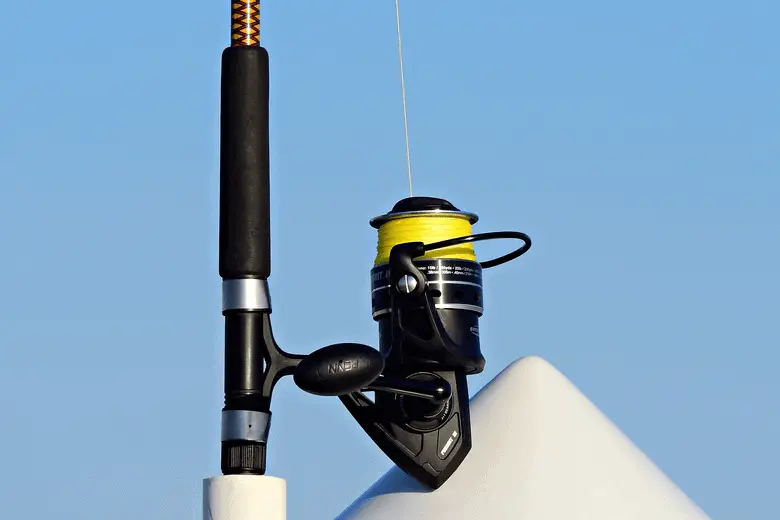My grandfather always boasted he could catch more fish with a handline than I could with my fancy rods and spin reels.
I’d retort, “You just can’t cast a spinning reel.” Learning how to cast a spin reel is reasonably straightforward.
You’ll eventually nail it even if you see yourself as uncoordinated or have questionable hand/eye coordination.
With the invention of the spin reel, casting became child’s play. No more backlash, no more birds’ nests. It quickly became the most popular reel type.
Mastering spin reel casting may take some time, however. You can become a master much sooner if you learn to do it correctly, using the right gear.
Let’s check out how to cast a spinning reel.
Page Contents
Benefits of Spinning Reels for Casting
The spin reel is the easiest to use and learn because it’s the most forgiving of all the reel types.
Conventional reels and baitcasters require greater timing, rig tying, and better reel fine-tuning.
They also require brake settings, which can be tricky for the novice.
The angler must use thumb control on the spool to mitigate backlash or overrun.
Overrun, often known as backlash, is when the spool of a conventional/baitcaster reel travels faster than the line is peeling from it.
The result can be a tangle of line the likes of which you could never have imagined. We call it a bird’s nest.
Even though modern baitcasting reels have outstanding brake systems, backlash is always possible, even for the most experienced angler.
It takes quite some time to master the timing and feel of en baicasters. And the learning phase can become infuriating.
The novice angler can generate a messy bird’s nest on every throw.
These knots don’t come out easily. A handful of these moments can turn you off from fishing forever.
So, once you’ve mastered bird nest avoidance, you can then focus on distance and accuracy.
A spinning reel is configured very differently from a conventional reel. When you cast a spin reel, the spool does not rotate.
This means you aren’t subject to the punishment of backlash and the resulting bird’s nest.
Yes, wind knots and topknots can cause hassles with spin reels, but it’s rare and not in the same class as a baitcaster bird’s nest.
If you make a mistake with a spin reel, the consequences are negligible compared to the baitcaster. You also don’t need the timing, setup, and thumbing skills.
The dedicated angler can become a spin reel casting master in no time.
Here is what you need to become proficient at casting spin reels.
Get the Right Gear To Cast Effectively
Using the right gear is the best way to become skilled at casting a spinning reel. While spin gear is very forgiving, it must still be appropriate for the application – you need a balanced outfit.
Balanced Outfit – Rod and Reel
A balanced outfit is a rod and reel combination suited to each other. For example, a game fishing rod is best fitted with a game fishing reel.

A small finesse rod is best fitted with a small finesse reel. It’s not much more complicated than that; it’s about weight and proportions.
A small 2500 reel designed for panfish will cast poorly on a heavy-duty 14-foot rod.
A poorly balanced outfit invites poor casting distance and accuracy.
Balanced Rig
A balanced outfit needs a balanced rig. If your rig is poorly balanced, it doesn’t matter how sweet your outfit is; casting will be challenging.
The rig is the hook, lure, sinkers, bait, leader, swivels, etc. How are they placed on the line, spaced on the line, and how much do they weigh?
It’s also a bad idea to spool up your 1000 finesse spinning reel with 100-pound mono and strap it to a medium-light 12-foot surf rod.
For example, A 2-ounce weight on a 6-foot medium/light rod is a bad combination. Expect trouble, even a snapped rod.
An example of a balanced outfit is a 12-foot medium heavy surf rod holding a 4000 or 5000 spin reel, packed with 15 to 20-pound braid or mono.

Another good example for a beginner is a 7.5-foot medium rod, armed with a 3000 spinning reel, spooled with a 10-12 pound braid or mono. It’s perfect from a dock or gentle bank.
You don’t need years of experience to create a balanced outfit and rig. Firstly, it’s common sense, and you’ll invariably feel when something is out of kilter with a rod and reel.
Having said that, if you’re new to spinning reels and rods or fishing generally, it’s best to take advice from your local pro or an experienced friend.
The best way to understand how our balance can impact casting is to visit a tackle shop and handle the countless combos on the racks.
Ask the retailer if he’ll make up a miss-match for you so you can feel how awkward a poorly balanced outfit feels.
Manufacturers include all of the performance specs for rods and reels. You can match your rod and reel with these specs and a little assistance from your local pro.
Many helpful sites online can show you how to rig for perfect casting while keeping your application and target the priority focus.
If you’re conscientious, you’ll have no trouble getting suitably equipped and rigged – do the research and understand what kit your fishing passions demand.
How to Cast a Spinning Reel
Step 1 – Grip the fishing rod with your dominant hand. Use your index finger to hold the fishing line against the rod grip several inches before the bail arm. Make sure there aren’t any loops or loose line going from your hand back to the spool. There is a possibility that line will loop around the bail, foot, or handle in the event of windy conditions. Should you try to launch your bait a mile with a line hung up on obstacles, you are very likely to lose your expensive lure as the line snaps with a loud bang.
Step 2 – Approach the water, get stable, and ready to cast. When you’re feeling comfortable and ready to cast, pull the bail arm over. Your finger grip on the line is all important now. The rod should be comfortably in front of you, probably in two hands.
Step 3 – Extend your casting arm out to the side. Your rod tip should be pointing slightly above the horizontal level. Now, smoothly and gradually, swing the fishing rod back behind you. Keeping your wrist relatively straight delivers the best results.
Step 4 – As the rod reaches its farthest point back, smoothly cast it forward. Focus on a smooth rhythm over power for best results when you’re learning. Swing the rod over your shoulder toward your target.
Step 5 – When the rod tip reaches a point above the horizon between 10 and 11 o’clock, release your finger and let the line peel from the spool.
Step 6 – When your bait or lure hits the water, the line will go slack momentarily. Crank the handle to close the bail arm (auto bail) or flick the bail closed if manual. Quickly glance at your spool and ensure it’s free of any loops or loose line.
It may take several casts for the beginner to get a feel for the timing.
Usually, it’s the release point most beginners will struggle with initially. Another common learning curve is finger strength to hold the line securely as you load up the rod with force.
Casting a spinning reel is all about feel. And feel will remain a critical aspect of casting your spin reel, as baits, weights, weather, and line class vary from session to session.
Frequently Asked Questions
How much line is enough on a spinning reel?
Optimum casting performance is achieved when your spool is full, just below the spool lip.
As your spool empties, distance and accuracy will be compromised by friction as the line has more contact with the spool and spool lip.
Too much line can be a nightmare. Never overfill a spin reel. When it’s too full, the line has a habit of peeling off in clusters of loops. Your cast will be poor, and you can expect knots.
How can I improve my casting distance?
Casting distance will improve with practice. The trick is to get as much power into the cast while keeping it smooth and controlled.
Better distance is always achieved when your rigs are perfectly balanced – the right sinker for the line class and rod class.
I always advise novices to feel the difference between casting a heavy mono carolina rig on an 8-foot rod and a mid-weight metal slice with braid on a 12-foot rod.
This experiment gives you a feel for the physics of casting and how nothing beats a perfectly weighted lure on the end of your mainline or leader.
Surf and rock anglers are always seeking more distance. Their distance trick is simple; longer rods.
Sharing is caring!

